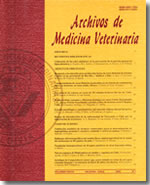Main musculoskeletal injuries associated with lameness in Chilean Rodeo horses
Main Article Content
Abstract
Chilean Rodeo is the most popular equestrian discipline in Chile and it is estimated that musculoskeletal diseases of the equine participants are the leading cause of illness and poor performance, however no related reports have been published. The aim of this study was to identify and characterize the main diseases associated with lameness in Chilean Rodeo horses. A retrospective study was performed considering the clinical attention records of horses participating in Chilean Rodeo which presented lameness. Information was collected regarding 114 cases, including identification (name, age and gender) and the clinical characteristics of each episode. The average age of the horses was 8 ± 3.4 years. Among the subjects, 98.3% of the episodes corresponded to spontaneous lameness, with 2/4 being the most frequent degree of lameness. Unilateral episodes corresponded to 72.8% (83/114) of the cases, affecting primarily the front limbs (51/83). The most frequent diagnoses were: suspensory ligament desmitis (14%), tarsal osteoarthritis (13.2%), navicular syndrome (8.8%), laminitis (7.9%), deep digital flexor tendonitis (7%) and metacarpophalangeal osteoarthritis (6.1%). The high frequency of grade 2 lameness suggests that the majority of veterinary attentions seem to be mostly at obvious conditions. Joint, foot and soft tissue conditions seem to be the main cause of lameness in equines participating in Chilean Rodeo. These results suggest that education regarding the importance of early diagnosis and greater hoof care are primary measures that may favor the prevention of lameness in Chilean Rodeo horses.

